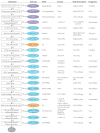Biologic and Therapeutic Implications of Genomic Alterations in Acute Lymphoblastic Leukemia
- PMID: 34501239
- PMCID: PMC8432032
- DOI: 10.3390/jcm10173792
Biologic and Therapeutic Implications of Genomic Alterations in Acute Lymphoblastic Leukemia
Abstract
Acute lymphoblastic leukemia (ALL) is the most successful paradigm of how risk-adapted therapy and detailed understanding of the genetic alterations driving leukemogenesis and therapeutic response may dramatically improve treatment outcomes, with cure rates now exceeding 90% in children. However, ALL still represents a leading cause of cancer-related death in the young, and the outcome for older adolescents and young adults with ALL remains poor. In the past decade, next generation sequencing has enabled critical advances in our understanding of leukemogenesis. These include the identification of risk-associated ALL subtypes (e.g., those with rearrangements of MEF2D, DUX4, NUTM1, ZNF384 and BCL11B; the PAX5 P80R and IKZF1 N159Y mutations; and genomic phenocopies such as Ph-like ALL) and the genomic basis of disease evolution. These advances have been complemented by the development of novel therapeutic approaches, including those that are of mutation-specific, such as tyrosine kinase inhibitors, and those that are mutation-agnostic, including antibody and cellular immunotherapies, and protein degradation strategies such as proteolysis-targeting chimeras. Herein, we review the genetic taxonomy of ALL with a focus on clinical implications and the implementation of genomic diagnostic approaches.
Keywords: B-ALL; BCL11B; DUX4; IKZF1; NOTCH1; NUTM1; PAX5; Ph-like; T-ALL; ZNF384; genome; transcriptome.
Conflict of interest statement
I.I. has received honoraria from Amgen and Mission Bio; S.K. declares no conflict of interest.; C.G.M. has received research funding from Loxo Oncology (relevant to the use of TRK inhibition in Ph-like ALL), AbbVie (venetoclax in ALL) and Pfizer; honoraria from Amgen and Illumina. These funders had no role in the writing of this manuscript.
Figures


References
-
- Stock W., Luger S.M., Advani A.S., Yin J., Harvey R.C., Mullighan C.G., Willman C.L., Fulton N., Laumann K.M., Malnassy G., et al. A pediatric regimen for older adolescents and young adults with acute lymphoblastic leukemia: Results of CALGB 10403. Blood. 2019;133:1548–1559. doi: 10.1182/blood-2018-10-881961. - DOI - PMC - PubMed
-
- Montefiori L.E., Bendig S., Gu Z., Chen X., Polonen P., Ma X., Murison A., Zeng A., Garcia-Prat L., Dickerson K., et al. Enhancer hijacking drives oncogenic BCL11B expression in lineage ambiguous stem cell leukemia. Cancer Discov. 2021 doi: 10.1158/2159-8290.CD-21-0145. - DOI - PMC - PubMed
Publication types
LinkOut - more resources
Full Text Sources
Other Literature Sources
Miscellaneous

